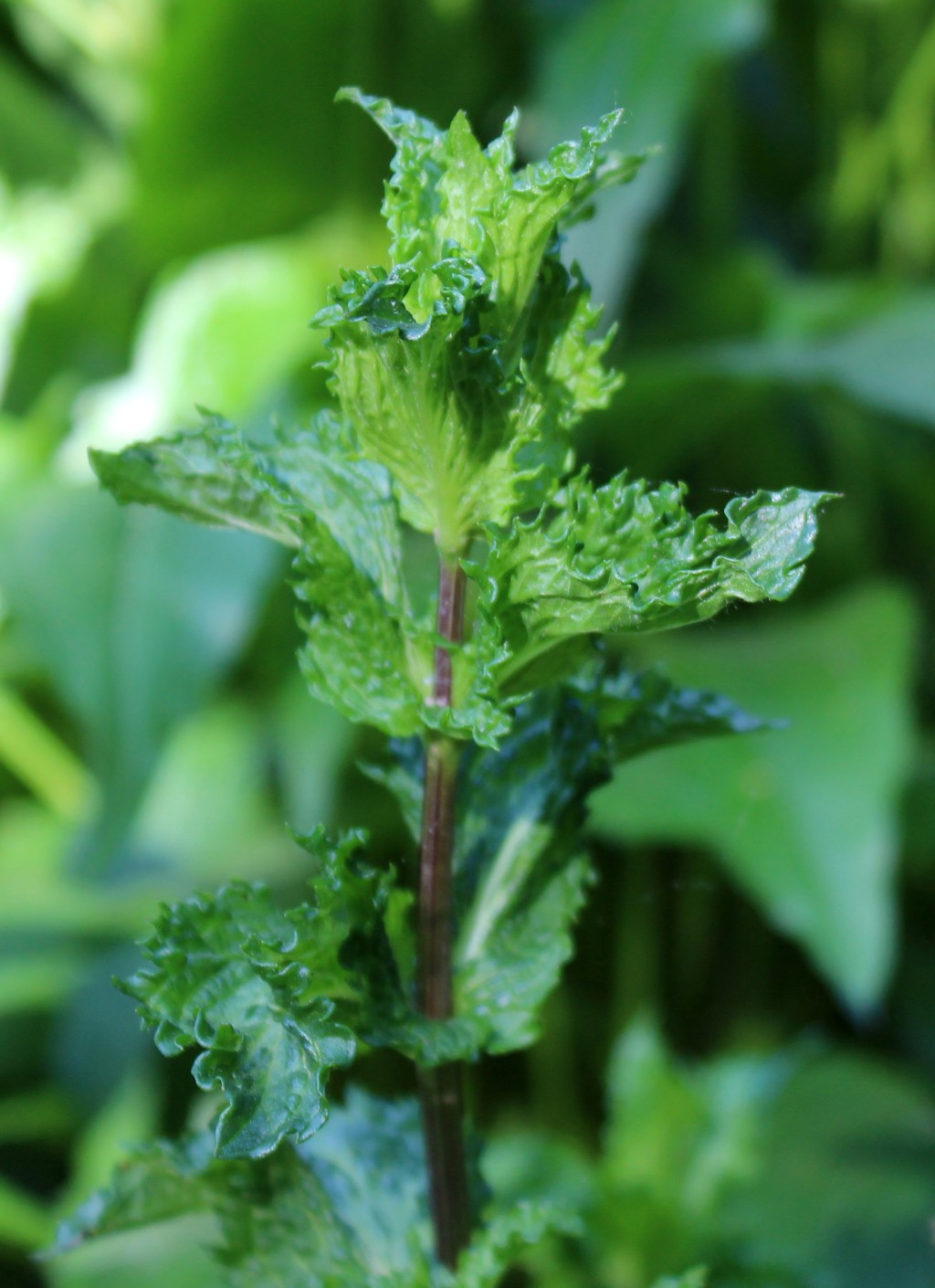Herb: Spearmint
Spearmint, Mentha spicata, is a culinary herb used to flavor sweets and beverages.
Mint grows about 18 inches tall and will bush out if the stem ends are regularly pinched off. Mint has spikes of white to light pink flowers.
Spearmint Characteristics
- perennial
- erect stem to 3 feet tall, sometimes reclining or creeping
- stems greenish, not purplish as in peppermint
- oval leaves toothed, pointed at tips
- leaves stalkless, opposite
- tiny flowers in terminal, interrupted spikes
- purple to pinkish tubular flowers in whorls
- stamens protruding, purplish anthers
- found in moist areas, garden escapes
Spearmint Uses
- medicinal
- culinary
- gardening
Growing Spearmint
Growing conditions: Mint can be started by seed indoors and transplanted to a sunny to partially sunny location outdoors after the danger of frost is past. Shade tolerant. Frequent cuttings spur growth.
Light: sun, partial shade
Height: 18 inches
Spacing: 18 inches
Planting comments: Rhizomes are invasive. If cutting tops is not enough to keep mint from spreading too far, plant a bucket with holes in the bottom in the place where the mint is to be planted. Plant spearmint in the bucket to retain the roots in a small area and reduce its invasive tendencies.
Where to Buy Spearmint
Spearmint is available as seeds or plants. Depending on the time of year you may be able to find a plant at your nearby garden center. In case they’re are not available locally, here are some places that offer herb seeds and herb plants.
- Abundant Life Seeds Cottage Grove, OR
- Artistic Gardens / Le Jardin du Gourmet St. Johnsbury Center, VT
- Baker Creek Heirloom Seeds Mansfield, MO
- Bluestone Perennials, Inc. Madison, OH
- BorgheseGardens.com Gautier, MS
- Bountiful Gardens Palo Alto, CA
- Companion Plants Athens, OH
- Ed Hume Seeds Puyallup, WA
- Eden Organic Nursery Services, Inc. Davie, FL
- GreenDealer Exotic Seeds Louisville, KY
- Heirloom Seeds West Elizabeth, PA
- Henry Field Seed and Nursery Co. Aurora, IN
- High Altitude Gardens Cornville, AZ
- Irish Eyes Garden Seeds Ellensburg, WA
- Jim Johnson, Seedman Gautier, MS
- John Scheepers Kitchen Garden Seeds, LLC. Bantam, CT
- Johnny’s Selected Seeds Winslow, ME
- Jung Quality Seeds Randolph, WI
- Logee’s Greenhouses, Ltd. Danielson, CT
- NESEED.com Hartford, CT
- Nichols Garden Nursery Albany, OR
- Ornamental Edibles San Jose, CA
- Otto Richter and Sons Limited. Goodwood, ON, Canada
- Peaceful Valley Farm Supply, Inc. Grass Valley, CA
- Pepper Gal Fort Lauderdale, FL
- Peters Seed and Research may be out of business,
- Pinetree Garden Seeds New Gloucester, ME
- R.H. Shumway’s Randolph, WI
- Redwood City Seed Co. Redwood City, CA
- Renee’s Garden Seeds Felton, CA
- Seed Savers Exchange Decorah, IA
- Southern Exposure Seed Exchange Mineral, VA
- Stokes Seeds Inc. Buffalo, NY
- The Cook’s Garden Warminster, PA
- Thompson and Morgan Jackson, NJ
- Underwood Gardens Chino Valley, AZ
- Veseys Seeds Ltd. Calais, ME
- Victory Seed Company Molalla, OR
- W. Atlee Burpee & Co. Warminster, PA
- Willhite Seed, Inc. Poolville, TX
In case you can’t find what you’re looking for commercially, take a look at some of the online seed swap sites where you can find many unusual plants and common ones, too.
Chef’s Article: Spearmint Flavors More Than Sweets
by Naomi Gallagher
Spearmint is a herb that comes from a perennial plant, Mentha spicata, a member of the mint family, Lamiaceae. Native to Europe and western Asia, it’s now naturalized in many places around the world, especially in moist, damp or wetland habitats. The leaves of spearmint and spearmint oil are used to flavor sweets and beverages.
Spearmint grows aggressively via underground rhizomes and surface runners. Unless the roots are restrained to a small area of a garden by some subterranean means, spearmint will invade areas adjacent to where the original plant was placed. Spearmint grows to two feet tall at which point the stems tend to lay over, as if reaching to grow out further from the mother plant. This helps the plant seek new areas as rooting will occur at the leaf nodes that touch the ground. It’s common to plant mint in pots or planters to contain its growth.
Stems of spearmint are square in cross-section, which is a characteristic shared by most members of the mint family. The bright green toothed leaves lie opposite one another. The leaves appear ruffled and come to a point at the tip, thus the name ‘spear’ mint.
Leaves of spearmint can be harvested throughout the growing season, but the aroma is strongest before flowering occurs. Pruning mint or pinching back the leaves will make the plant bushier and postpone flowering. The leaves can be used fresh, frozen, dried or preserved in sugar syrup or alcohol.
Spearmint is not very commonly used in cooking. Its flavor is more appreciated in beverages, sweets and confections. However, it can be used sparingly with chicken or pork, especially when blended with other herbs and spices. The main aromatic compound in spearmint is menthol. It leaves a cooling sensation in the mouth, so it balances well with spicy hot foods.
Mint sauce and mint jelly are ways to appreciate the cooling peppery taste of mint with other foods. Mint sauce is simple to make. Boil leaves in a heavy sugar syrup until the mint flavor is in the sauce. Then, strain the liquid to remove the leaves and discard them.
Beverages that are flavored with spearmint include iced sweet tea, hot or cold herbal teas, hot cocoa, coffee, and mixed drinks like the mint julep and mojito. Schnapps are liqueurs flavored with spearmint. All these beverages are a little extra special with a garnish of mint leaves.
Spearmint is a flavoring agent in toothpastes and mouth rinses. It’s also a scenting agent in toiletries like soaps and shampoos. Spearmint has antibacterial, antiseptic and antioxidant properties due to its menthol content.

